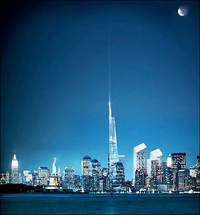Governor Eliot Spitzer changes his mind about supporting construction of Freedom Tower
A booming commercial real estate market and the need to move forward with rebuilding at ground zero changed Gov. Eliot Spitzer's mind about supporting the continued construction of the 1,776-foot (541-meter) Freedom Tower.

"We're confident that this is not only viable, but profitable," said Spitzer, who appeared together with New Jersey Gov. Jon Corzine and Mayor Michael Bloomberg on Tuesday to sign off on the delayed, redesigned skyscraper that has been under construction for more than nine months.
Spitzer, who once called the planned building a "white elephant" that could not be profitable for the government agency that owned the World Trade Center, said after he was elected governor that he would look at the project again.
The federal and state government has promised to lease half of the tower's office space and skyscaper - which will cost more than $2.4 billion (EUR 1.8 billion) to build - is on budget, he said.
But Spitzer added, "I don't have any opposition" to selling the tower, which the Port Authority is scheduled to finish building by 2011. "We will entertain these options if and when they arise."
Corzine said that selling the tower "would be good public policy." He said the Port Authority, which is run by both governors and owns airports, shipping terminals and bridges, should stay focused more on transportation than real estate.
Private investors have recently come to the agency with interest in ownership and development rights for the skyscraper and a second tower under the agency's control, Port Authority officials have said.
The agency agreed to build and lease two of the five planned towers last year when it renegotiated its lease with private developer Larry Silverstein, who is building three other towers on the site. It is sharing more than $7 billion (EUR 5.3 billion) in insurance proceeds and tax-exempt bonds to rebuild office space destroyed by the Sept. 11, 2001, terrorist attack.
No design changes are foreseen, despite critics' complaints that the tower's height makes it too much of a terrorist target and that a 20-story, windowless base makes the building look too forbidding.
The base "speaks less of resilience and tolerance than of paranoia. It's a building armored against an outside world that we no longer trust," wrote New York Times architecture critic Nicolai Ouroussoff in a column on Monday, urging that the building be redesigned, the AP says.
Spitzer called the design a compromise "between the security needs that are real and pure aesthetics."
"I don't think it will look like a fortress," Bloomberg said. "There's nothing wrong with taking appropriate security actions."
Subscribe to Pravda.Ru Telegram channel, Facebook, RSS!




